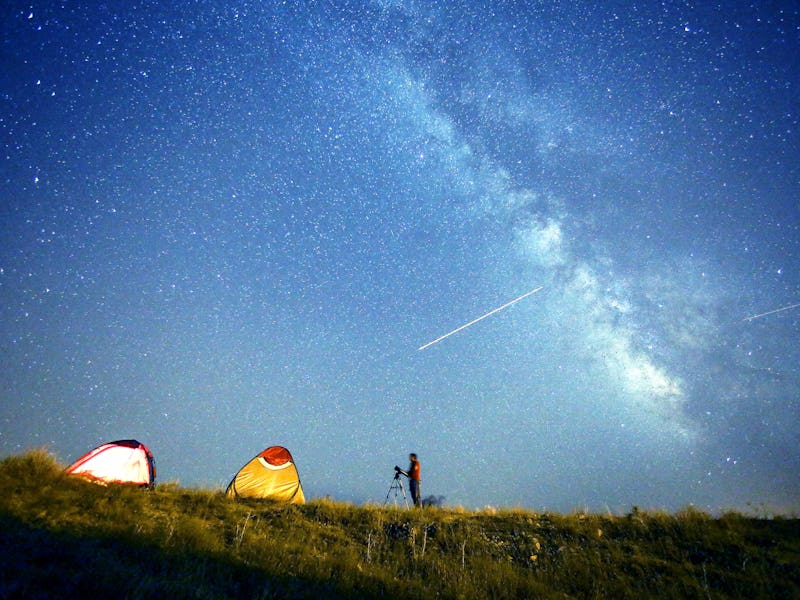The Annual Perseid Meteor Shower Peaks This Weekend and It Is A Must-See Event
Make a wish — or, with 50 to 100 meteors streaking across the sky every hour, make several.

This weekend is the perfect time to catch the year’s most spectacular — and easiest to watch — meteor shower, the Perseids.
The annual Perseid meteor shower will peak late on Sunday night and into the early predawn hours of Monday morning, but the Perseids should put on a spectacular late-night show from now through the middle of next week. Here’s everything you need to know, from how to watch the Perseids to the science behind the light show.
The Perseids are known for long, bright streaks of light.
When Is the Perseid Meteor Shower?
Short answer: Right now! The Perseid meteor shower happens around this time every year, from mid-July to early September, with a dramatic peak around August 12.
Meteor showers like the Perseids are a vivid reminder that we’re passengers on a ball of rock moving through space at more than 67,000 miles per hour — and right now, we’re flying through a stream of dusty debris left in the wake of a comet. Comet 109P/Swift-Tuttle makes a long loop around the Sun every 133 years, and it leaves a trail of dust, ice, and pebbles in its wake. Every year, at about the same point in Earth’s 365-day lap around the Sun, our planet crosses Swift-Tuttle’s debris trail. As that debris patters against Earth’s upper atmosphere, like bugs hitting the windshield of a passing car, it creates bright streaks of light in the sky.
What to Expect from the Perseid Meteors
At the peak of the Perseid meteor shower, between 50 and 100 meteors an hour will streak across the night sky. That’s a meteor or more every minute, so your chances of seeing several meteors are very good.
The Perseids are known for leaving bright, colorful streaks of light that can linger in the sky for several seconds; the longest, brightest streaks come from meteors that just skim the top of our atmosphere, instead of plunging straight in. Most of the streaks of light you’ll see during the Perseids are objects about the size of sand grains, disintegrating 50 miles above you at temperatures hotter than 3,000 degrees Fahrenheit. Larger grains, usually about an inch across, can burst apart in bright fireballs; if you’re lucky, you may spot a few of those an hour.
How to See the Perseid Meteors
The Perseids are one of the easiest meteor showers to watch, mostly because it offers so many meteors streaking across the sky, but also because Swift-Tuttle’s debris trail is so wide that we get several days of good viewing, unlike other meteor showers that may offer only a few hours of real meteor-watching. If the weather or your personal schedule don’t cooperate on the night of August 11, you can still see a fantastic show a few days before or after the shower’s peak.
As with any stargazing, darkness is key. You’ll want to get as far away from city lights as possible. The ideal meteor-watching spot is dark, with a wide-open view of as much of the sky as possible, but especially the north. Bring a lawn chair or blanket, and settle in. Turn off your headlights, flashlights, and cell phone, and give your eyes about 30 minutes to adjust to the darkness.
For casual viewers, meteors should be visible anytime after around 10pm local time, but the best views will be after midnight, when the bright half-Moon sets and leaves a dark sky for meteors to shine against. And the dark pre-dawn hours of Monday morning will offer the most and brightest meteors.
If going outside isn’t your thing, you can catch the Virtual Telescope Project’s livestream, starting at 9pm Eastern Time on August 11 and August 12.
This time-lapse photo shows the Perseids seeming to radiate from a point in the northern sky.
Do the Perseid Meteors Come from Perseus?
Short answer: no.
If you stare up at the night sky for long enough, you may notice that the Perseid meteors seem to radiate from a point somewhere in the constellation Perseus. It may look a little like the classic Windows 95 Starfield screensaver (for the history buffs out there who remember screensavers). That’s an optical illusion; as Earth flies through the cloud of dust and debris, the direction in which we’re moving will look like the center, from which all the meteors seem to radiate out and past us. In the case of the Perseids, that point is somewhere in the constellation Perseus, in the northern sky.
But the Perseid meteors are actually just bits of dust and tiny pebbles that, at this moment, are in a cloud all around us.
Is Comet Swift-Tuttle Going to Crash Into Earth Someday?
Short answer: maybe, but not anytime soon.
Comet 109P/Swift-Tuttle is the largest object that regularly crosses Earth’s orbit and passes close to our planet, so astronomers have kept a close eye on it. They’ve calculated its orbit, and ours, for about the next 2,000 years, and Swift-Tuttle is in no danger of hitting Earth until sometime after the year 4400 (and even then, the chances aren’t huge). So you can relax and enjoy the show.
If Swift-Tuttle eventually does hit Earth, it’s going to wreck everything. The nucleus — the actual ball of ice and dust that forms the main body of a comet — of Swift-Tuttle is about 16 miles wide, which makes it twice the size of the object that smashed into the Yucatan Peninsula 65 million years ago and ended the dinosaurs’ world. Because of how much faster Swift-Tuttle moves in relation to Earth, though, it would hit with about 27 times as much force as the Chicxulub object.
Good thing we don’t have to worry about that.